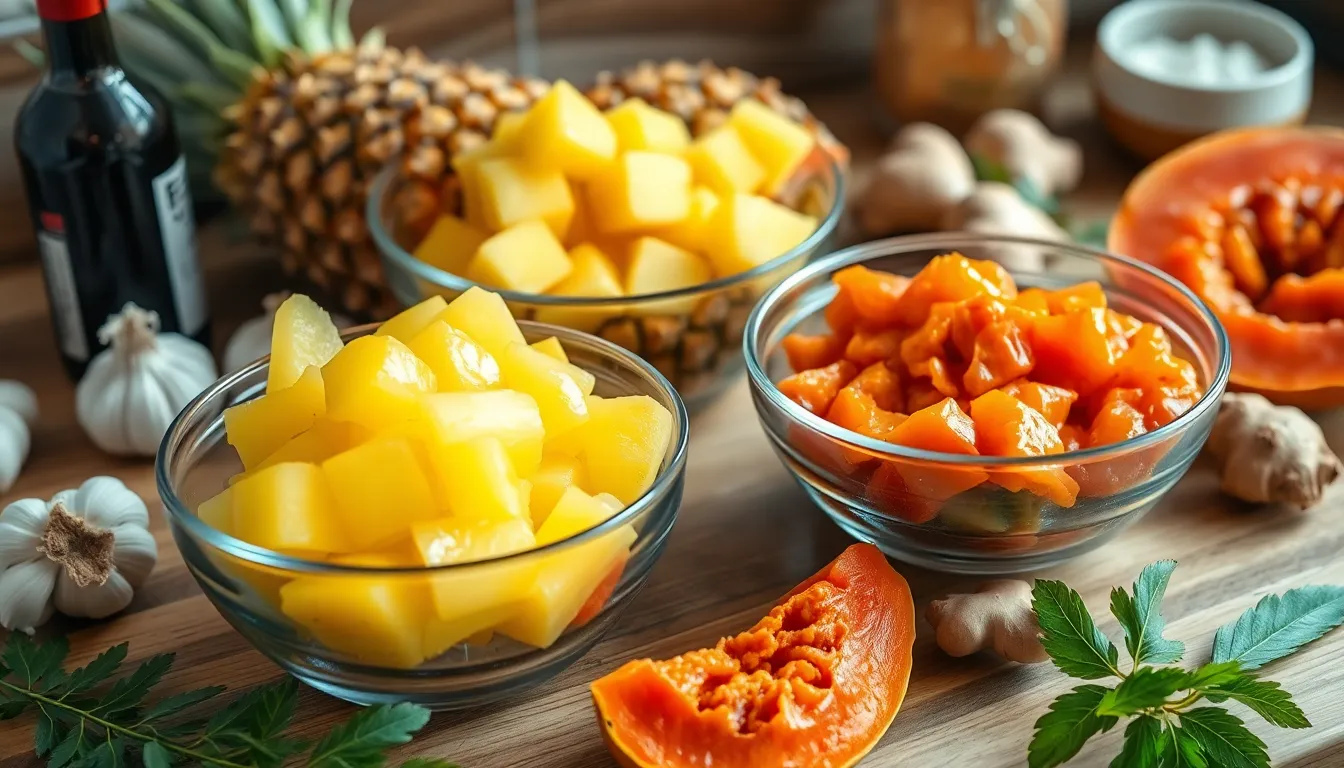Cooking the perfect steak or roast often hinges on one crucial factor: tenderness. Tough cuts of meat can turn a promising meal into a disappointing experience, but mastering meat tenderizing techniques can transform even the most resilient cuts into mouthwatering delights. Whether it’s a family gathering or a casual dinner, knowing how to properly tenderize meat can elevate any dish.
From mechanical methods like pounding to natural solutions such as marinades, various techniques exist to break down tough fibers and enhance flavor. Each method has its own unique benefits and can be tailored to suit different types of meat. Understanding these techniques not only improves the texture of the meat but also enriches the overall dining experience, making it a vital skill for any home cook or culinary enthusiast.
Table of Contents
ToggleUnderstanding Meat Tenderizing Techniques
Meat tenderizing techniques enhance the texture and flavor of various cuts. They fall into two primary categories: mechanical methods and natural methods.
Mechanical Methods
- Pounding: Pounding meat with a mallet breaks down tough fibers. This method is effective for steaks and can create a more uniform thickness for even cooking.
- Tenderizing Tools: Using specialized tenderizing tools, like blades or forks, creates small incisions in the meat. This process facilitates moisture and marinade absorption.
- Brining: Soaking meat in a saltwater solution draws moisture into the meat. This technique not only tenderizes but also adds flavor.
Natural Methods
- Marinating: Marinades often include acids, such as vinegar or citrus juice, which break down proteins. A marinade can infuse flavor while improving tenderness.
- Enzymatic Solutions: Ingredients like pineapple or papaya contain natural enzymes that effectively tenderize meat. Using pureed or crushed fruit in marinades can produce desirable results.
- Aging: Aging meat allows natural enzymes to break down muscle tissue over time. This method improves tenderness and flavor, often seen in high-quality cuts.
Understanding these techniques empowers home cooks to improve meat dishes significantly. Adapting the right method to the meat type ensures delicious and satisfying meals.
Chemical Tenderizing Methods

Chemical tenderizing methods leverage specific ingredients to break down proteins in meat, enhancing texture and flavor. Two primary types of chemical methods include enzymatic and salt-based marinades.
Enzymatic Marinades
Enzymatic marinades utilize natural enzymes found in certain fruits to tenderize meat effectively. Pineapple contains bromelain, while papaya includes papain; both enzymes target protein structures, making tough cuts more palatable. When marinating, using fruits contributes both flavor and tenderness. Typically, marinating meat for 30 minutes to 2 hours suffices, depending on the type and size of the meat.
Examples of enzymatic marinades include:
- Pineapple marinade: Blend fresh pineapple juice with garlic, soy sauce, and ginger for a tropical flavor.
- Papaya marinade: Combine mashed papaya with lime juice and cilantro for a refreshing option.
Salt-Based Marinades
Salt-based marinades enhance meat’s tenderness by drawing moisture into the protein through osmosis. Salt not only flavors meat but also changes its molecular structure, making it more tender. A well-balanced brine usually consists of 1/4 cup of salt per quart of water, infused with herbs and spices for added flavor.
Common salt-based marinades include:
- Classic brine: Water, salt, sugar, and spices create a versatile solution suitable for various meats.
- Herbed brine: Infuse water with salt and fresh herbs like rosemary and thyme for aromatic effects.
Using chemical tenderizing methods effectively improves meat’s overall quality, leading to a more enjoyable dining experience.
Mechanical Tenderizing Techniques
Mechanical tenderizing techniques enhance meat texture by physically breaking down tough fibers. These methods not only ensure even cooking but also allow for better moisture absorption.
Pounding and Beating
Pounding and beating utilize a mallet or other heavy objects to tenderize meat. These actions break apart muscle fibers and create a uniform thickness, resulting in more even cooking. Pounding also enables marinades to penetrate deeper, further enhancing flavor and tenderness. Cook the meat carefully after pounding to maintain optimal texture.
Scoring
Scoring involves making shallow cuts on the surface of the meat. This technique allows marinades to penetrate more efficiently, enhances cooking evenness, and reduces shrinkage during cooking. Scoring creates greater surface area, which aids in enhancing flavor absorption. Ensure the cuts are not too deep to avoid compromising the integrity of the meat.
Cooking Methods for Tender Meat
Cooking methods significantly impact meat tenderness. Utilizing specific techniques can enhance texture and flavor, ensuring a satisfying dining experience.
Slow Cooking
Slow cooking involves low temperatures and extended cooking times, allowing collagen in tough cuts to break down into gelatin. This process creates flavorful, tender meat. Common methods include using a slow cooker, braising, and roasting.
- Slow Cooker: Maintains a consistent low heat over several hours, ideal for cuts like chuck roast or brisket.
- Braising: Combines both wet and dry heat, starting with browning the meat, then simmering in liquid for several hours. This method works well with stews or pot roasts.
- Oven Roasting: Cooking at low temperatures (around 225°F to 300°F) for longer periods helps tenderize tougher meat cuts.
High-Temperature Cooking
High-temperature cooking methods create a flavorful crust while keeping the inside tender. These techniques effectively cook premium cuts of meat quickly.
- Grilling: Direct heat sears the meat, forming a flavorful exterior and juicy interior. Ideal for steaks and chops, a high grill temperature ensures a perfect char without overcooking.
- Broiling: Similar to grilling, broiling cooks meat at high heat from above. This method, suitable for thicker cuts, caramelizes sugars on the surface while retaining moisture inside.
- Searing: Briefly cooking meat at high temperatures before finishing it through another method locks in juices and enhances flavor, particularly in steaks and roasts.
Employing slow or high-temperature cooking can dramatically improve tenderness, making meals more enjoyable.
Natural Tenderizing Agents
Natural tenderizing agents effectively break down tough meat fibers, enhancing the overall tenderness. Common sources include fruits, vegetables, and dairy products.
Fruits and Vegetables
Fruits like pineapple, papaya, and kiwi contain proteolytic enzymes that break down protein structures, making them excellent natural tenderizers. For example, bromelain from pineapple and papain from papaya are highly effective, requiring only 30 minutes to a few hours of marination to achieve desired tenderness. Additionally, vegetables such as tomatoes and onions offer acidity, which helps in protein breakdown. The use of marinades incorporating these fruits and vegetables not only tenderizes meat but also adds distinctive flavors, enhancing overall dish quality.
Dairy Products
Dairy products act as effective meat tenderizers due to their lactic acid content and enzymes. Yogurt and buttermilk create a tenderizing effect by adhering to meat surfaces and promoting enzymatic activity. For instance, marinating meat in yogurt for several hours can result in a noticeably more tender texture; the acids in the dairy break down the meat’s fibers while adding moisture. This method is particularly beneficial for lean cuts, allowing home cooks to elevate the tenderness and flavor of their dishes.
Mastering meat tenderizing techniques can transform ordinary cuts into culinary delights. Whether utilizing mechanical methods like pounding and scoring or embracing natural solutions such as marinating with fruits or dairy, each approach offers unique benefits. The choice of cooking method further influences tenderness, allowing for both slow and high-temperature options to shine.
By understanding and applying these techniques, home cooks can elevate their dishes, ensuring every meal is a memorable experience. With a little knowledge and practice, anyone can achieve perfectly tender meat that impresses family and friends alike.


